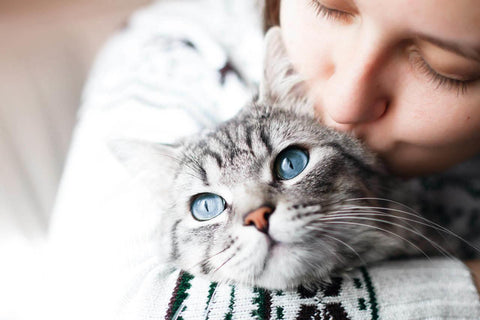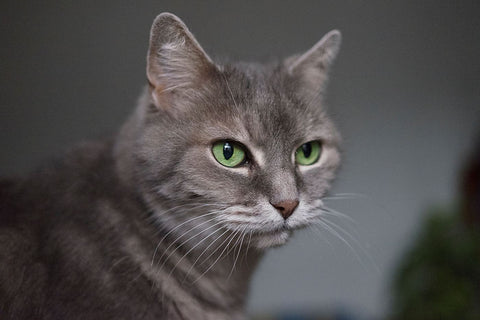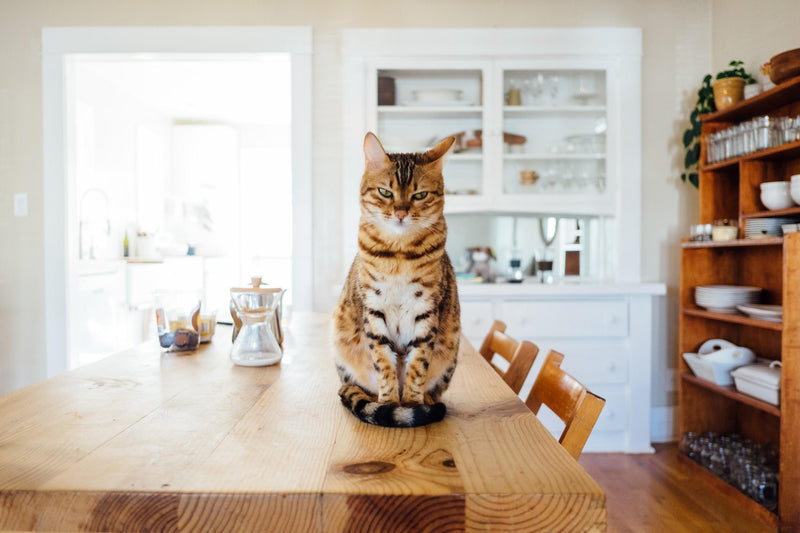
This knowledge also enables you to make educated choices about foods and nutritional changes as your cat matures and moves through life-stages.
First, it is good to have baseline information. Using Basepaws Cat DNA Test Kit will help you understand not only the basics when it comes to your cat's breed but underlining health conditions that may affect your cat's nutrition and weight-loss goals. Sudden changes in weight or appetite may indicate health concerns and should be assessed by a veterinarian.
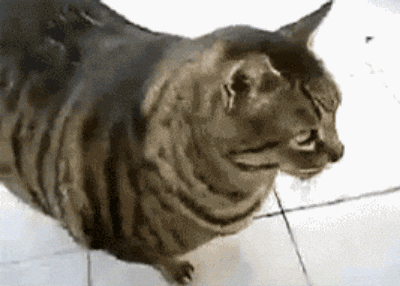
How to Weight Your Cat
Check out this fantastic video on how to weigh your cat at home!
Baby Scale
If you have access to a baby scale, this is a quick and convenient way to weigh your cat. These scales are somewhat bulky and hard to store, though, so if you do not have one on hand, using a human scale works too, instructions to follow. For the baby scale, place a towel on top and then hit Tare/Zero to ensure the scale is at 0 before placing your cat in the towel. For nervous cats, a little bit of high-value treats may work well here to keep them in place just long enough to get a weight. Try to keep them from moving too much while the scale is working.
Human Scale
As long as your cat doesn't mind being picked up, this can be a quick and easy way to get a baseline and monitor weight. Weigh yourself first, without the cat, then again, but this time holding your cat. The difference is your cat's weight.
For example: Without holding a cat, a person weighs 162.3 lbs. Then holding the cat, they weigh 174.6. By subtracting these two numbers, we know the cat weighs 12.3 lbs.
Training your cat to sit on the scale is absolutely possible and is the EASIEST way of getting your cat to weigh themselves! Check out this incredible video of Mystic the Bengal weighing himself!
Cat Body Condition Score
Here is a great video to help you learn more about obtaining a body condition score by Hill’s Pet Nutrition.
Just like people, the number on the scale does not tell the whole story. Since the build of cats can vary along with muscle and bone density, we need to assess not only the weight but also the body condition of the cat. Body condition helps us to evaluate the amount of fat storage and your cat's muscle tone or lack of both. There are two commonly used Body Condition Score (BCS) Scales, one measure on a scale from 1-5 the other on a scale of 1-9, but they both assess the same aspects of body composition with the low end of the scale being thin and the high end being obese.
To obtain a BCS on your cat, you will need to palpate (feel) and visualize (look at) your cat's body composition. We want to assess your cat from both above and from the side. Start with a visual inspection of your cat. Looking at them from above, do they have a tucked, straight or bulging waistline? Ideally, there will be a slight hourglass shape with the tuck being right behind the ribs when viewed from above. Next, take a look at your cat from the side. Is there an upward angle between the ribs and hind legs? Is there a slight or significant belly sag?
Next, we want to feel the body composition or palpate our cat to determine how much fat we feel in areas that have a propensity to store fat. The first place to start is the ribs. You should be able to feel the ribs independently easily. You should feel a thin layer of fat over the ribs, similar to the back of your knuckles when making a fist. We can also palpate the fat pouch on the abdomen to assess for fat storage, as well as the pelvis and backbone. When petting your cat, you should readily feel these bone structures without them being visually assessed or protruding.

We can now assign a number to your cat's BCS based on this assessment. The chart below will give you more information on assigning a number based on what you see and feel.

Bigger is Not Always Better
It is an unfortunately common misconception that cats need to be big, even obese, to be healthy. The Garfield physique is what many people think of when they picture a cat, but this is not healthy for our cats. Excess body fat is associated with diabetes, urinary disease, osteoarthritis, decreased life span(2), reduced grooming ability due to impaired range of motion, inflammation, and even cancer. Maintaining a healthy body weight is the best way to keep your cat healthy and happy for as long as possible!
Setting Healthy Goals
It is essential to work on a healthy weight goal with your cat's veterinarian. They will be able to determine the healthiest weight loss goal, including currently fit for weight loss and exercise status, elimination of any medical factors affecting weight, the best food for the nutritional management of any current diseases or health conditions, and assessment of daily caloric needs. We will discuss all of these factors from a general standpoint for the "average cat" but strongly recommend working out the particulars with your veterinarian. Once you have determined the goal weight, it is essential to understand that healthy weight loss does not happen fast, and small losses are a big deal! In cats, and again, generally speaking, we would expect no more than 0.5% and 2% weight loss per week. This can be just ounces for the average-sized cat.
It is also great to set "non-scale goals," such as increased duration and frequency of activity and play. Cats do most things in small, short-bursts. We want to keep this in mind when considering cat enrichment. Play sessions will likely be short 2-5 minutes, but they can be frequent throughout the day. Experimenting with toys to find what your cat enjoys can help to increase play duration and frequency. Fishing style toys make great playtime additions that can encourage movement and chasing. These games increase mobility but also enrich the brain and hunting instincts, so they are essential additions to any cat's day.
Look for interactive toys, brain games, and other toys that kitty finds enjoyable on their own. These toys can encourage movement when no one is home or available to play.
The foundation of health is nutrition, no matter your cat's current life stage, a lifetime of health includes proper nutrition. But we know that choosing food can not only be confusing, but it may seem impossible. Especially if you have a more choosy feline. We are going to try to break down some of that information here, decode the mystery and demystify the myths of choosing your feline's diet. Still, it is essential to remember to discuss nutritional choices and food changes with a member of your cat's veterinary team. Ensuring you are meeting their specific requirements based on current weight, health conditions, and life-stage. These topics are meant to cover the basics of cat nutrition and are not specific recommendations for your cat nutrition and weight management. All specific recommendations should come directly from a veterinary professional with an established doctor-patient relationship.
Food Choices and Cat's Basic Needs
We all know cats are unique. Their diet is no different. To better understand the basics of cat nutrition, we will first look at the dietary needs of cats.
Cats are obligate carnivores, which means animal proteins are the primary source of nutrition and only a small amount from fats and carbohydrates. They also have specific nutritional supplementation needs, including essential amino acids such as Taurine, Methionine, and Cystine, to name a few, and vitamins such as A, D & B3. In general, complete and balanced manufactured diets include the appropriate amounts of each of these essential dietary components. High-quality manufactures ensure these needs are met, and it is one reason it is necessary to ensure a reputable company produces your food.
Determining if your cat will eat canned or dry food is often difficult for many cat owners. If cats are obligate carnivores, can they eat dry food? The answer depends on several factors. First of all, budget, availability, and preferences must be considered. If your cat won't eat canned food, no matter what, well, then they are, plainly not going to get the cat nutrition they need. Canned food has several benefits as well as disadvantages over dry foods.
Canned food offers more water content, increasing water intake for your cat, as well as higher protein and lower carbohydrates. In general, most cats seem to enjoy canned food. Canned food comes in many different flavors and textures, so experiment if you do not find a food your cat likes right away, they may prefer a different taste, texture combination. Canned food is not quite as economical of choice for feeding, and may not be an option for some cat owners based on budget. Also, canned food is not as easily used in feeder toys and brain challenge feeders, and uneaten portions must be refrigerated.
Dry food can still be a healthy option for our carnivorous family cats. The important part is that we limit the carbohydrates and ensure the food we buy is balanced with the appropriate recommended amount of protein, fats, and carbohydrates to meet the energy needs of your cat through the proper amount of calories and quality ingredients. Most veterinary professionals agree to offer at least some portion of the diet as canned food is best for cats. Dry kibble may be used in feeder toys and games to supplement the diet in a balanced way with limited use of treats, which are often more calorically dense and may have a lower nutrient profile.
AAFCO Nutrient Requirements for cats are a baseline guideline for the nutrient requirement amounts for cats.
Counting Calories
Just like humans, calories are energy measurements in the cat's diet. Work with your veterinarian to determine the ideal weight for your cat and the number of calories needed based on current body condition score, life-stage, energy expenditure, lifestyle, and any health conditions that need to be considered.
It is important to remember that calories should be calculated based on the ideal weight, not the current weight of the cat. The scale on the back of food containers/bags is often a broad range. More specific determination is recommended. In general, the average cat weighs approximately 8-10 lbs. Larger cats may be as much as 10-12 lbs on average. If your cat weighs 14lbs, but your veterinarian advises a healthier weight would be 10lbs, calculate the caloric needs for your cat based on a mass of 10lbs. A very general guideline is approximately 20 calories per pound per day. So, a 10 lb cat would require about 200 calories per day.
Remember, all food intake includes the calorie count for the day. All treats included! It is easy to forget just how quickly they can add up, especially if there are several members of the same household who give the cat treats. Without knowing it, all members of the home could be doubling the daily calorie intake of your cat through treats! If the house has multiple members, consider separating the daily treat allowance for your cat and ensure this is all the family gives between all members.
Every food container will provide information about the number of calories per given quantity. Many food bags now provide calories per cup, but others will show the measurement expressed as a weight volume. In this case, you will have to weigh the food to determine the weight per cup before you can determine the calories per cup.
Feeding the appropriate calories of a balanced and nutritious diet will ensure that the dietary needs of your cat are met and under normal health conditions should not require supplementation.
Reading Labels
Besides calories, the label will hold much of the information we need to determine the quality of the diet, although it is not always where we think it may be.
While we often hear the most about ingredients when it comes to cat nutrition, however, they are not necessarily the determining factor of the quality of food. One of the most important things to determine first when choosing a diet is the presence of the "Nutritional Adequacy Statement," also known as the "AAFCO statement." AAFCO stands for Association of American Feed Control Officials, the group that publishes nutritional profiles for pets. The AAFCO statement is on the packaging, often near the ingredients and nutritional profiles, it may be small writing or challenging to find. If you are unsure, you can always contact the manufacturer to determine this statement applies to your cat's food.
The AAFCO statement will tell us three important things about the food:
- If the food meets all the nutritional requirements as determined by AAFCO.
- How this was determined?
- Life stage (baby, adult, senior, pregnant/lactating) the food is intended for (not always the same as the life stage it appears to be marketed for)
You can find more great information on reading pet food labels on the AAFCO website.

Keep in mind the AAFCO statement is not an assessment of product ingredient quality or manufacturing process. It is a report that assesses the food that is supposed to contain nutrients within the minimum and maximum quantities recommended for a healthy pet, not that it has evaluated the final product, or how it assessed the profiles. For this reason, it is essential to ensure a quality manufacturer produces the food.
Within cat nutritional foods there is no shortage of choices when it comes to diets. Determining which is the best can be mind-boggling. Many options will have the AAFCO statement, so how do we narrow down our picks and look past the marketing to determine food quality? Again, ingredients are not always the first thing we look to.
Before we consider the ingredients and their quality, we first want to look to the manufacturer, as this can be a significant factor in assessing the quality of the ingredients and product.
Store-brand foods outsource their packaging and do not supply it themselves, and big brand stores do not manufacture their own food. Be sure the manufacturer on the label owns the plant where the food is being produced:
- Manufacturers should employ at least one qualified nutritionist (in animal nutrition).
- Manufacturers should have stringent quality control, end-product testing, and audit measures in place.
- Diets should be subject to AAFCO feeding trials at best, at minimum assessments of finished product nutrient profiles.
- When requested, manufacturers should be willing to provide assessment outcomes.
Another critical aspect of understanding the nutrient profile is understanding the concept of dry matter basis evaluation of nutrients. To accurately compare foods, you have to "extract" the quantity of moisture present. Extracting moisture outlines a more accurate comparison of fat, proteins, and carbohydrates and allows for comparison of wet and dry foods. To find the dry matter, you need the percent of the ingredient value and the percent of moisture. The equation is:

For example: if canned food is 78% water and dry food is 11% water, let's compare their protein content. Let's evaluate both if they both say 6% fat minimum.
Dry: 6% divided by 100%-11% x 100=6.74% fat
Canned: 6% divided by 100%-78%x100=27.27% fat
Extracting moisture content for comparison can help you evaluate the value of the food. When comparing products, take into consideration the quantity required to meet caloric needs, or the nutrient density, as well as the nutrients on a dry matter basis. This information can give a more clear picture of the nutrient availability in food. There are dry matter calculators online that can help make comparisons easier.
Remember, the minimums and maximums are listed and are a range for guidance, so the exact amount of the specific nutrient may not be precise. For more specific values, check the manufacturer's website or contact them for more information on "As Fed Values."

Quality Foods and Ingredients
OK, finally, let's talk about ingredients. The fact is, ingredient labels can be very misleading, and marketing has contributed to some of the myths and misnomers about ingredients. First, let's cover some of the definitions.
AAFCO defines what constitutes many of the guiding definitions for our understanding of the ingredients and their meanings. AAFCO also tells us the portions of the source utilized to provide the ingredients. Misconceptions are surrounding the quality of the protein sources used based on the ingredient title. After reading the AAFCO definitions, how many ingredients did you find you had previous misconceptions about?
Ingredients are listed from most to least, the same as human food labels. Much of what has been labeled by marketing as "fillers" or "by-products" are more concentrated high-quality nutrients. For example, evaluating "meat" vs. "meat by-product"; meat can be over 70% water, and by-products are concentrated forms of the same protein, but with as little as 10% moisture. Because of ingredient listing requirements, and the fact it would take much more meat than meat by-product to provide the same amount of nutrients, the meat would likely end up higher on the ingredient list, but they would offer the same quantity of nutrients.
Another ingredient listing "trick" for some manufacturers is ingredient splitting. Ingredient splitting is the practice of subdividing ingredients to decrease their relative quantity, therefore moving other more "desirable" ingredients up the ingredient list to create the appearance of more of that ingredient in the food than there is if the split ingredients were more appropriately represented. For example, marketing has targeted corn as a filler, and it is a less nutritious ingredient than meat, so manufacturers may split the ingredient listing into the various forms of corn to make the quantity lower, as well as the appearance of less filler, with meat, pushed higher to the top of the list. They may divide 20% corn into 10% cornflour and 10% cornmeal to split the larger quantity into less on the list, and therefore moving other ingredients such as chicken up the list of ingredients.
Being educated on these common myths and marking tactics will help ensure you can feel more confident about the food choices you make for your cat.
Homemade Diets
Homemade diets have grown in popularity with many pet owner communities as cat nutrition and weight management rises in search term engines. While these diets are highly controversial among veterinary professionals, it is essential to understand the nutritional requirements of your pet and ensure these are being met when feeding a homemade diet. Cooking homemade diets requires working closely with a veterinary nutritionist to ensure the diet you are feeding is complete and balanced, and that nutritional requirements are being met.
Myth Busting
There are many misconceptions and myths around the pet food industry that create confusion around the processing of ingredients, contents, or quality of food. Understand that many of the labels we see in pet foods today are not regulated titles and hold no standard for accountability. These include organic, holistic, and human-grade labels on pet foods. Use caution when food labels with catchy titles are part of the marketing of pet foods and determine what standards are used to establish these labels before deciding they contribute to the value of the nutrient profile of foods.
Major food manufacturers cut corners, use cheap products, and fillers in foods. As discussed above, most major manufacturers have long-standing standards of best practices, quality control, and processing methods. These standards provide a reliable product history, research, and expertise behind all foods. This is not to say that smaller label brands are not high quality, but more discretion may need to be used in the evaluation of product quality assessment and development.
What about grains?
Recently there has been a lot of discussion surrounding grain-free diets as the FDA released a list of diets with a potential link to cardiomyopathy in dogs. There is more research to be done, and these current associations are based on observed associations by veterinary cardiologists of several hundred dogs with cardiomyopathy. In some cases, these dogs were found to be taurine deficient, but not in all cases. This has led to speculation surrounding taurine and cardiomyopathy, but not enough understanding has been established to make this association with confidence. It is enough, however, for many veterinary professionals to feel grain-free diets need to be carefully evaluated for the AAFCO statement ensuring all nutritional needs are present and balanced in the food. This can help to ensure these deficiencies are not present in a balanced diet.
Human Grade
Association of American Feed Control Officials (AAFCO) as a product where "every ingredient and the resulting products are stored, handled, processed, and transported in a manner that is consistent and compliant with regulations…for human-edible foods". This does not mean the product is a higher quality ingredient and can be highly misleading.
Regardless of the food and feeding methods you choose, ensure you know how much your cat is eating and ensure caloric needs are being met, but not exceeded. This can pose a challenge for multi-cat households. These cat owners may want to consider using feeders that recognize chips on the collar and can aid in tracking how much each cat is eating. This is not quite as easy with feeders, but regulated amounts can be put in toys and monitored while cats play. Multi-cat households may also benefit from combination feeding techniques to monitor food intake minimums and monitor body condition and weight of each cat to ensure they are not taking more than their share of the resources.
One other consideration to mention for cat owners to consider is that each cat is different and that they will have different feeding habits. Some cats are more social feeders and will wait until there are family members present, in some cases other cats or pets, to eat their portions whenever possible. If you find your cat is not eating, spend time sitting near or around their food source and see if they are more inclined to eat when you are present. Conversely, other cats may prefer to eat when there are no other perceived competitors present. Observing your cat's preferences is the best way to establish their eating norms and behaviors most natural to them being able to observe changes in these behaviors and any concerns in feeding changes.
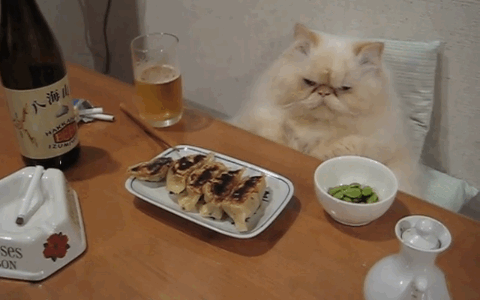
Summary
Cats are prone to lazy days full of naps and snacks, but that doesn't have to be the only activities in their schedule. Kitties need to play, climb, chase, and hunt to meet their natural internal instincts. By creating a habit of regular play and interaction, kitties will be on their way to a healthier physical and mental lifestyle. By focusing on goal weights as well as goal activity times, we can increase the movement and calories burned daily. At the same time, continue monitoring the intake of calories and ensuring their nutritional needs are being met, but not exceeded.
Check out the animated version of this article:
Resources:
https://vetnutrition.tufts.edu/2019/02/human-grade/
https://vetnutrition.tufts.edu/2016/01/important-information-you-could-be-misreading-on-the-pet-food-label/
http://veterinarycalendar.dvm360.com/cats-obligate-carnivore-proceedings
https://www.aafco.org/consumers/what-is-in-pet-food
https://vet.osu.edu/vmc/companion/our-services/nutrition-support-service/myths-and-misconceptions-surrounding-pet-foods
Meet the author: Beckie Mossor, RVT
Beckie is a Registered Veterinary Technician living in Southport, NC. She has enjoyed a diverse career in small animal, large animal, and mixed practices, academia, management, and private consultant. Beckie is co-founder of Veterinary Advancements, a private consulting firm, and is a professional medical responder with the ASPCA Cruelty Recovery Team. She is the host of Clinician’s Brief the Podcast and co-hosts Veterinary Viewfinder and Making Sense of Pets podcasts.
In support of her profession, Beckie is proud to serve as Executive Director for the Human-Animal Bond Association, Member at Large for the Society for Veterinary Medical Ethics, and former Executive Board Member for both the national and state technician associations.
As a Basepaws coach for Coach My Cat, Beckie uses her experience and knowledge of cat nutrition and behavior to guide clients through a better understanding of their cats' needs. As a Coach, Beckie can help address behavioral, nutritional, or environmental and questions for new and experienced cat owners alike!
Coach My Cat
Coach My Cat makes direct learning and support more accessible to cat guardians. We connect you with a personal Cat Coach to help you better understand the health and behavior of your cat. Learn more here.

